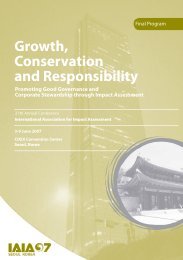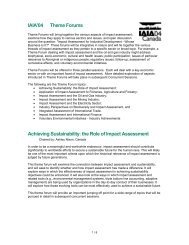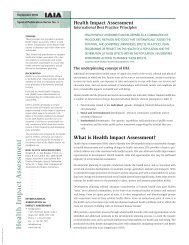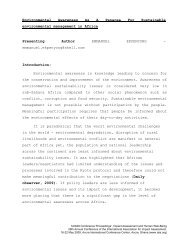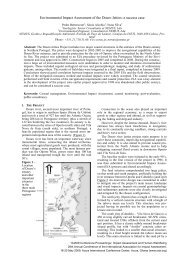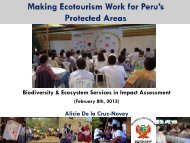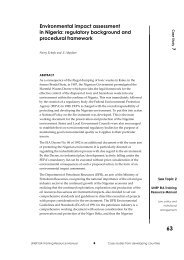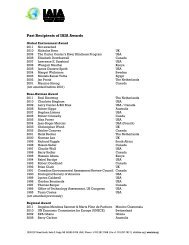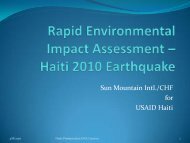Advancing the EIA system in the Philippines - UNEP
Advancing the EIA system in the Philippines - UNEP
Advancing the EIA system in the Philippines - UNEP
You also want an ePaper? Increase the reach of your titles
YUMPU automatically turns print PDFs into web optimized ePapers that Google loves.
<strong>Advanc<strong>in</strong>g</strong> <strong>the</strong> <strong>EIA</strong> <strong>system</strong> <strong>in</strong> <strong>the</strong> Philipp<strong>in</strong>es<br />
Maya Gabriela Villaluz<br />
Case Study 26<br />
THE PRESENT SYSTEM<br />
The Philipp<strong>in</strong>e Environmental Impact Assessment (<strong>EIA</strong>) System was<br />
formally established <strong>in</strong> 1978 with <strong>the</strong> enactment of Presidential Decree no.<br />
1586. The <strong>in</strong>stitutionaliz<strong>in</strong>g of its implement<strong>in</strong>g rules and regulations was<br />
completed four years later. A number of laws have been passed through <strong>the</strong><br />
years aimed at streng<strong>the</strong>n<strong>in</strong>g, expand<strong>in</strong>g and ref<strong>in</strong><strong>in</strong>g <strong>the</strong> exist<strong>in</strong>g <strong>system</strong>s<br />
and procedures. The Department of Environment and Natural Resources<br />
was given <strong>the</strong> task of adm<strong>in</strong>ister<strong>in</strong>g <strong>the</strong> <strong>EIA</strong> <strong>system</strong> through <strong>the</strong><br />
Environmental Management Bureau and its regional offices. Projects with<br />
potentially significant environmental impacts were categorized ei<strong>the</strong>r as<br />
environmentally critical or located <strong>in</strong> environmentally critical areas. Projects<br />
under <strong>the</strong> first category had to undergo full-scale <strong>EIA</strong> studies while those <strong>in</strong><br />
<strong>the</strong> latter category were submitted to Initial Environmental Exam<strong>in</strong>ations.<br />
Government entities were given mandates to establish <strong>the</strong>ir own<br />
environmental units, <strong>in</strong>tegrate environmental concerns <strong>in</strong> <strong>the</strong>ir plann<strong>in</strong>g and<br />
project cycles and assist <strong>in</strong> expedit<strong>in</strong>g <strong>the</strong> review process.<br />
A detailed procedural manual issued <strong>in</strong> 1992 discussed <strong>the</strong> step-by-step<br />
procedure <strong>in</strong> <strong>the</strong> preparation and review of Environmental Impact<br />
Statements. The manual conta<strong>in</strong>ed guidel<strong>in</strong>es for (among o<strong>the</strong>r th<strong>in</strong>gs):<br />
• <strong>the</strong> form and content of <strong>the</strong> documentation requirements;<br />
• <strong>the</strong> conduct of consultations to show proof of social acceptability;<br />
• <strong>the</strong> composition of <strong>the</strong> external Review Committee;<br />
• <strong>the</strong> allocations <strong>in</strong> an Environmental Guarantee Fund; and<br />
• <strong>the</strong> creation of a multi-partite Monitor<strong>in</strong>g Team.<br />
The second edition of <strong>the</strong> manual provided a detailed discussion of <strong>the</strong><br />
guidel<strong>in</strong>es <strong>in</strong> <strong>the</strong> conduct of <strong>the</strong> follow<strong>in</strong>g:<br />
• scop<strong>in</strong>g<br />
• <strong>the</strong> procedural and substantive review<br />
• Environmental Risk Assessment<br />
• Environmental Management Plans<br />
• public hear<strong>in</strong>gs and consultations.<br />
See Topic14<br />
<strong>UNEP</strong> <strong>EIA</strong> Tra<strong>in</strong><strong>in</strong>g<br />
Resource Manual<br />
Strategic<br />
Environmental<br />
Assessment<br />
257<br />
<strong>UNEP</strong> <strong>EIA</strong> Tra<strong>in</strong><strong>in</strong>g Resource Manual ® Case studies from develop<strong>in</strong>g countries
A w<strong>in</strong>dow for an accelerated process<strong>in</strong>g of applications was opened to<br />
proponents who chose to contribute to an Environmental Review Fund that<br />
was set up to defray <strong>the</strong> cost of pool<strong>in</strong>g a dedicated team of external experts<br />
to review and process <strong>the</strong> applications. The accelerated process<strong>in</strong>g time<br />
should be no more than 120 days. An average contribution would be around<br />
half a million pesos (13,160 USD) per project. A breakdown of <strong>the</strong> cost of<br />
review is also provided <strong>in</strong> <strong>the</strong> manual.<br />
In spite of its streng<strong>the</strong>ned features, <strong>the</strong>re is a mount<strong>in</strong>g concern that <strong>the</strong> <strong>EIA</strong><br />
<strong>system</strong>, even <strong>in</strong> comb<strong>in</strong>ation with exist<strong>in</strong>g environmental legislation, is still<br />
not enough to combat <strong>the</strong> escalat<strong>in</strong>g deterioration of <strong>the</strong> environment. In<br />
response to this concern, <strong>the</strong> government is implement<strong>in</strong>g a number of<br />
projects aimed at pilot-test<strong>in</strong>g <strong>the</strong> <strong>in</strong>tegration of different strategies and<br />
frameworks <strong>in</strong> environmental management.<br />
ISSUES AND CONCERNS<br />
Intent and tim<strong>in</strong>g of <strong>the</strong> <strong>EIA</strong> process<br />
The <strong>EIA</strong> <strong>system</strong> has been largely perceived as cater<strong>in</strong>g only to <strong>the</strong> needs of<br />
<strong>the</strong> <strong>in</strong>dustrial sector. The predom<strong>in</strong>ant practice is to subject to an <strong>EIA</strong> study<br />
specific projects <strong>in</strong> pre-determ<strong>in</strong>ed locations ra<strong>the</strong>r than analyze <strong>the</strong><br />
environmental impacts of a mix of projects and locations. In many cases, a<br />
major stumbl<strong>in</strong>g block to <strong>the</strong> <strong>EIA</strong> process is <strong>the</strong> lack of a deliberate move<br />
from all sectors to embark on <strong>the</strong> process right at <strong>the</strong> beg<strong>in</strong>n<strong>in</strong>g of <strong>the</strong> project<br />
cycle. This dilemma is compounded by <strong>the</strong> seem<strong>in</strong>gly lack of political will to<br />
ensure earlier assessment.<br />
Institutional capacity of <strong>the</strong> implement<strong>in</strong>g agency<br />
Devolv<strong>in</strong>g <strong>the</strong> task to <strong>the</strong> regional offices to issue and monitor<br />
environmental clearances cover<strong>in</strong>g <strong>the</strong> whole range of projects is tak<strong>in</strong>g a<br />
long time to implement, due to <strong>the</strong> lack of both competent government<br />
personnel and readily available expertise and resources at <strong>the</strong> national and<br />
local levels. The law itself did not create permanent career positions for <strong>EIA</strong><br />
professionals <strong>in</strong> <strong>the</strong> government service.<br />
The regulations do not prescribe <strong>the</strong> methodologies to be used dur<strong>in</strong>g <strong>the</strong><br />
conduct of <strong>the</strong> study; nei<strong>the</strong>r do <strong>the</strong> reviewers verify it dur<strong>in</strong>g <strong>in</strong> <strong>the</strong>ir<br />
review of <strong>the</strong> EIS. There still rema<strong>in</strong>s a large gap <strong>in</strong> <strong>the</strong> procedural<br />
guidel<strong>in</strong>es of <strong>the</strong> review. The monitor<strong>in</strong>g capability of government needs a<br />
lot of streng<strong>the</strong>n<strong>in</strong>g. There are no programmes <strong>in</strong> place, no equipment<br />
available, and <strong>the</strong>re are not enough tra<strong>in</strong>ed staff or accredited laboratories to<br />
analyze <strong>the</strong> samples.<br />
Due to <strong>the</strong> absence of basel<strong>in</strong>e environmental data, consultants generally<br />
have to ga<strong>the</strong>r basel<strong>in</strong>e <strong>in</strong>formation for every <strong>EIA</strong> study <strong>the</strong>y conduct, or<br />
collect secondary data generated by similar studies, which <strong>in</strong> many cases are<br />
258<br />
<strong>UNEP</strong> <strong>EIA</strong> Tra<strong>in</strong><strong>in</strong>g Resource Manual ® Case studies from develop<strong>in</strong>g countries
scanty and unreliable. More often than not, <strong>the</strong> period of sampl<strong>in</strong>g is<br />
shortened and does not capture <strong>the</strong> vary<strong>in</strong>g conditions attributable to <strong>the</strong><br />
chang<strong>in</strong>g seasons and o<strong>the</strong>r natural or man-made phenomena. There is no<br />
central repository of environmental data that can be easily accessed by <strong>the</strong><br />
consultants or stakeholders nor is <strong>the</strong>re a database of <strong>the</strong> basel<strong>in</strong>e<br />
<strong>in</strong>formation conta<strong>in</strong>ed <strong>in</strong> <strong>the</strong> various <strong>EIA</strong> studies submitted.<br />
There is also an apparent lack of coord<strong>in</strong>ation and an overlapp<strong>in</strong>g of<br />
functions between <strong>the</strong> government agencies mak<strong>in</strong>g <strong>the</strong> process more<br />
circuitous, time-consum<strong>in</strong>g and <strong>in</strong>effective.<br />
For <strong>the</strong> most part, public hear<strong>in</strong>gs and public consultations are haphazardly<br />
conducted and poorly presented due to time constra<strong>in</strong>ts and <strong>the</strong> lack of<br />
skills with<strong>in</strong> government to handle social issues. Documents are not freely<br />
accessible to <strong>the</strong> public due to fear, uncerta<strong>in</strong>ty and a lack of experience <strong>in</strong><br />
handl<strong>in</strong>g seem<strong>in</strong>gly contentious matters.<br />
RECOMMENDATIONS<br />
The Government should streng<strong>the</strong>n <strong>the</strong> use of <strong>the</strong> <strong>EIA</strong> <strong>system</strong> as a plann<strong>in</strong>g<br />
and monitor<strong>in</strong>g tool ra<strong>the</strong>r than a command and control <strong>in</strong>strument <strong>in</strong> order<br />
to optimize scarce resources and effectively implement <strong>the</strong> <strong>system</strong>. The<br />
government needs to rationalize its present structure <strong>in</strong> order to provide<br />
opportunities for growth and satisfaction to its personnel. Tra<strong>in</strong><strong>in</strong>g and<br />
career opportunities should also be provided to keep experienced and<br />
competent staff from leav<strong>in</strong>g <strong>the</strong> government service.<br />
The methodologies used <strong>in</strong> <strong>the</strong> preparation of environmental assessment<br />
studies, <strong>the</strong> conduct of reviews and <strong>the</strong> monitor<strong>in</strong>g of compliance should be<br />
apparent to <strong>the</strong> stakeholders. Systems should be put <strong>in</strong> place so as to raise<br />
confidence among <strong>the</strong> stakeholders <strong>in</strong>volved <strong>in</strong> <strong>the</strong> decision-mak<strong>in</strong>g process.<br />
It is of <strong>the</strong> utmost importance that transparency <strong>in</strong> <strong>the</strong> conduct of <strong>the</strong> study<br />
should be observed <strong>in</strong> order to ma<strong>in</strong>ta<strong>in</strong> <strong>the</strong> impartiality of <strong>the</strong> entire<br />
process. The accreditation of <strong>the</strong> consultants and <strong>the</strong> reviewers should be<br />
strictly enforced <strong>in</strong> order to ma<strong>in</strong>ta<strong>in</strong> <strong>the</strong> <strong>in</strong>tegrity and <strong>the</strong> professionalism of<br />
<strong>the</strong> process.<br />
There should be a dedicated commitment from <strong>the</strong> government to<br />
streng<strong>the</strong>n <strong>the</strong> laws, rules and guidel<strong>in</strong>es perta<strong>in</strong><strong>in</strong>g to <strong>the</strong> <strong>EIA</strong> <strong>system</strong>.<br />
There is a grow<strong>in</strong>g need to <strong>in</strong>tegrate <strong>the</strong> different environmental regulations<br />
<strong>in</strong>to one coherent law so as to make <strong>the</strong> entire process more effective and<br />
consistent. Legislation should reflect <strong>the</strong> present aspirations of society and<br />
should not delay <strong>in</strong> address<strong>in</strong>g those needs. The public should be given <strong>the</strong><br />
right to participate <strong>in</strong>, and be <strong>in</strong>formed of, <strong>the</strong> decisions made <strong>in</strong> matters<br />
concern<strong>in</strong>g <strong>the</strong> environment so as to <strong>in</strong>crease <strong>the</strong>ir awareness and<br />
participation <strong>in</strong> a process that greatly determ<strong>in</strong>es <strong>the</strong>ir well-be<strong>in</strong>g and <strong>the</strong>ir<br />
entire future.<br />
259<br />
<strong>UNEP</strong> <strong>EIA</strong> Tra<strong>in</strong><strong>in</strong>g Resource Manual ® Case studies from develop<strong>in</strong>g countries
The author:<br />
Maya Gabriela Villaluz<br />
Department of Environment and Natural Resources<br />
17 Maria Elena St<br />
Hayaville Subd. Project 6<br />
Quezon City<br />
Metro Manila<br />
PHILIPPINES<br />
Key words<br />
<strong>EIA</strong><br />
procedures<br />
<strong>in</strong>stitutional<br />
capacity<br />
260<br />
<strong>UNEP</strong> <strong>EIA</strong> Tra<strong>in</strong><strong>in</strong>g Resource Manual ® Case studies from develop<strong>in</strong>g countries




![Session Report [PDF] - International Association for Impact Assessment](https://img.yumpu.com/22416146/1/190x245/session-report-pdf-international-association-for-impact-assessment.jpg?quality=85)
![Session Report [PDF] - International Association for Impact Assessment](https://img.yumpu.com/22416140/1/184x260/session-report-pdf-international-association-for-impact-assessment.jpg?quality=85)
